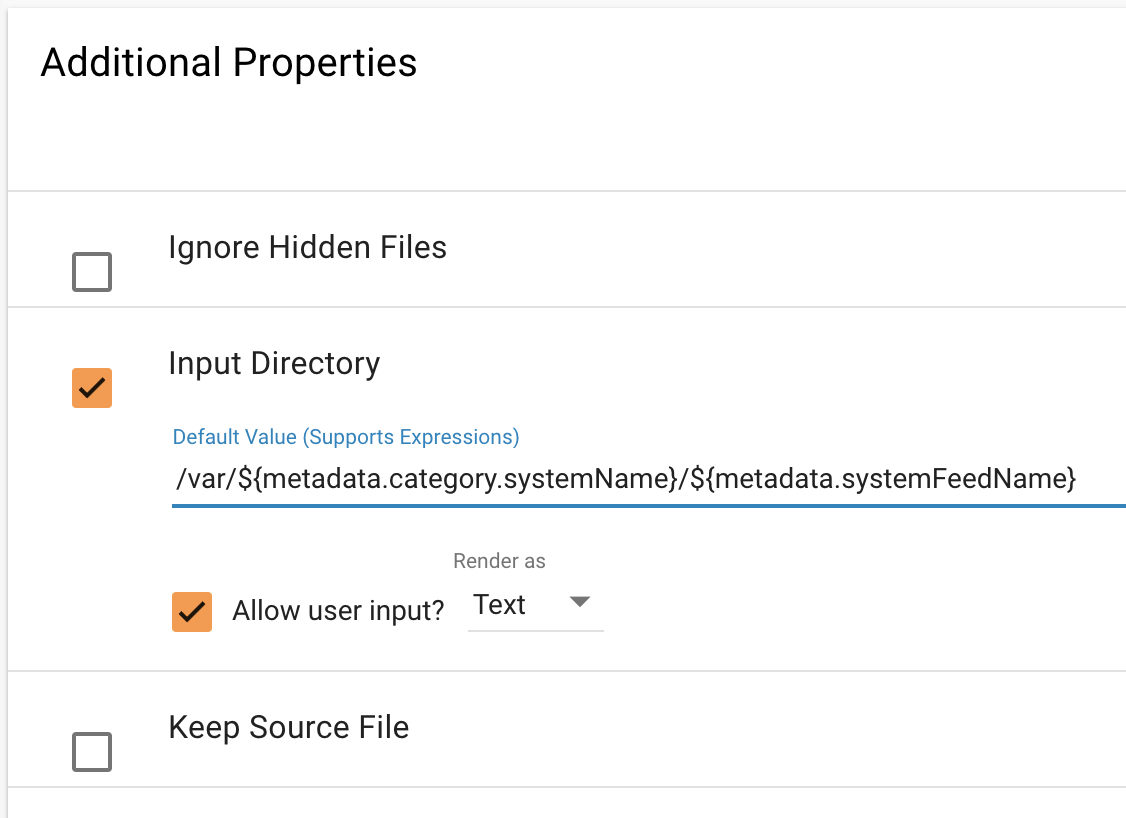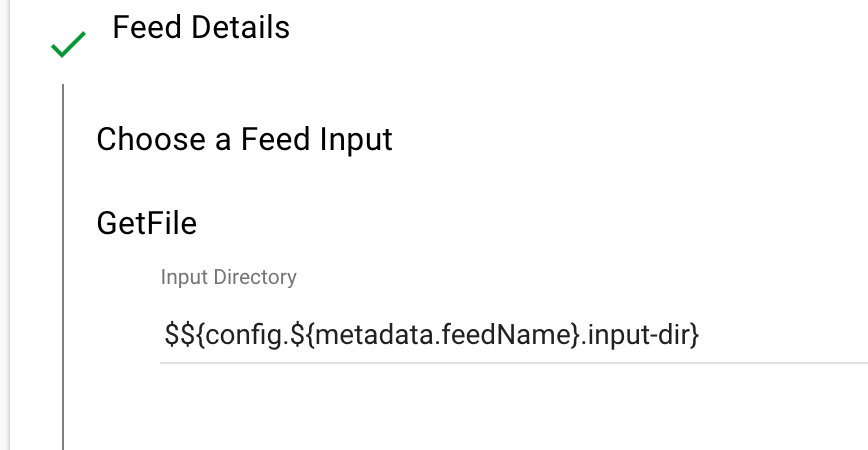Configuration Properties¶
Overview¶
This guide provides details on how to configure Kylo Templates and Feeds with properties from different sources. The sources can be the following:
- Configuration from application.properties
- Configuration from Feed Metadata
- Configuration from Nifi environment variables
There are two property resolution options:
- Design-time resolution
- Runtime resolution
1. Configuration Sources¶
1.1 Configuration from application.properties¶
When creating Kylo feeds and templates one can refer to configuration properties which appear in
/opt/kylo/kylo-services/conf/application.properties file. Property names must begin with word config. and they
should be referenced by following notation in Kylo UI ${config.<property-name>}
Here is an example of how we use this in application.properties
config.hive.schema=hive
config.props.max-file-size=3 MB
Here is how you would refer to config.props.max-file-size in Kylo template:
Setting NiFi Processor Properties¶
There is a special property naming convention available for Nifi Processors and Services in application.properties too.
For Processor properties four notations are available:
nifi.<processor_type>.<property_key>nifi.all_processors.<property_key>nifi.<processor_type>[<processor_name>].<property_key>(Available in Kylo 0.8.1)$nifi{nifi.property}will inject the NiFi property expression into the value. (Available in Kylo 0.8.1)
where <processor_type>, <property_key>, <processor_name> should be all lowercase with spaces replaced by underscores. The <processor_name> is the display name of the processor set in NiFi.
Starting in Kylo 0.8.1 you can inject a property that has NiFi Expression Language as the value. Since Spring and NiFi EL use the same notation (${property}) Kylo will detect any
nifi expression in the property value if it start with $nifi{property}
Setting properties matching the NiFi Processor Type. Here is an example of how to set ‘Spark Home’ and ‘Driver Memory’ properties on all ‘Execute Spark Job’ Processors:
nifi.executesparkjob.sparkhome=/usr/hdp/current/spark-client nifi.executesparkjob.driver_memory=1024mSetting properties for a named NiFi Processor (starting in Kylo 0.8.1). Here is an example setting the property for just the ExecuteSparkJob processor named “Validate and Split Records”:
nifi.executesparkjob[validate_and_split_records].number_of_executors=3 nifi.executesparkjob[validate_and_split_records].driver_memory=1024mSetting a property with NiFi expression language as a value (starting in Kylo 0.8.1). Here is an example of injecting a value which refers to a NiFi expression
nifi.updateattributes[my_processor].my_property=/path/to/$nifi{my.nifi.expression.property}The “my property” on the UpdateAttribute processor named “My Processor” will get resolved to
/path/to/${my.nifi.expression.property}in NiFi.Setting all properties matching the property key. Here is an example of how to set Kerberos configuration for all processors which support it:
nifi.all_processors.kerberos_principal=nifi nifi.all_processors.kerberos_keytab=/etc/security/keytabs/nifi.headless.keytab
Setting Controller Service Properties¶
For Services use following notation: nifi.service.<service_name>.<property_name>.
Anything prefixed with nifi.service will be used by the UI. Replace spaces in Service and Property names with underscores
and make it lowercase. Here is an example of how to set ‘Database User’ and ‘Password’ properties for MySql Service:
nifi.service.mysql.database_user=root
nifi.service.mysql.password=hadoop
1.2 Configuration from Feed Metadata¶
When creating Kylo feeds and templates you can also refer to Feed Metadata, i.e. set property values based on known
information about the feed itself. These properties start with word ‘metadata’, e.g. ${metadata.<property-name>}
Here is how you would refer to Category name and Feed name in Kylo template:
1.3 Configuration from Nifi environment variables¶
TODO - Help us complete this section
2. Property Resolution Options¶
2.1 Design-time Resolution¶
These properties will be resolved at design-time during Feed creation from Template. They use the following notation ${property-name}.
If you had property-name=value in application.properties and ${property-name} in Template then static value would be placed
into Processor field in Nifi on Feed creation.
You can also provide nested properties or properties which refer to other properties ${property-name2.${property-name1}}
If you had property-name1=value1 and property-name2.value1=value2 in application.properties and
${property-name1.${property-name2}} in Template then static value2 would be placed into Processor field in Nifi on Feed creation.
Note
This type of resolution is great for properties which do not support Nifi’s Expression Language.
2.2 Runtime or Partial Resolution¶
If you don’t want to resolve properties at design time and would rather take advantage of property resolution at runtime by Nifi’s
Expression Language then you can still refer to properties in Kylo Feeds and Template, just escape them with a dollar sign $ like so:
$${config.${metadata.feedName}.input-dir}. Notice the double dollar sign at the start. This property will be resolved at
design-time to ${config.<feed-name>.input-dir} and will be substituted at runtime with a value from application.properties file.
So if you had a feed called users and config.users.input-dir=/var/dropzone/users in application.properties then at
runtime the feed would take its data from /var/dropzone/users directory.
Note
This type of resolution is great for creating separate configurations for multiple feeds created from the same template


